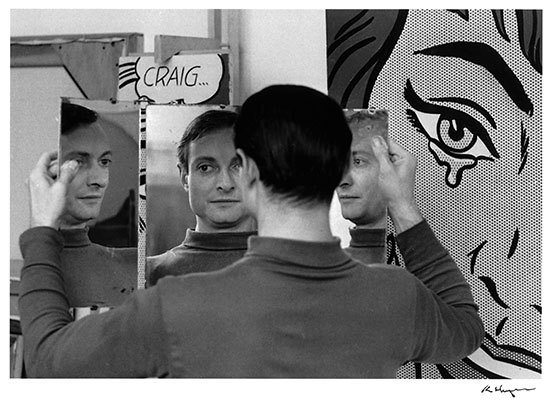
Roy Lichtenstein (October 27, 1923 – September 29, 1997) was a famous American Pop artist and was noted for his bright and catchy colours graphic works
Life
- On October 27, 1923, Lichtenstein was born in New York.
- He became interested in art and design through school and often painted portraits of musicians playing musical instruments.
- In 1937, Lichtenstein decided to take up watercolour classes at the Parsons School of Design. Aside from this course, he studied in the Art Students League, was taught by Reginald Marsh, a famous realist painter.
- In 1943, Lichtenstein’s school life at Ohio State University was interrupted by WW2. He was drafted for the war and sent to Europe until 1946.
- After the war, Lichtenstein came back to Ohio State and finished his college education in fine arts. Hoyt L. Sherman had an important influence on him in this period, he encouraged Lichtenstein to keep questioning of accepted canons of taste. By the way, Lichtenstein gave his first son the middle name of “Hoyt,” and in 1994 he donated funds to endow the Hoyt L. Sherman Studio Art Center at OSU.
- Then, Lichtenstein got a master’s degree, and then took a job at Ohio State University, experienced as a commercial art instructor, industrial engineer and window display designer.
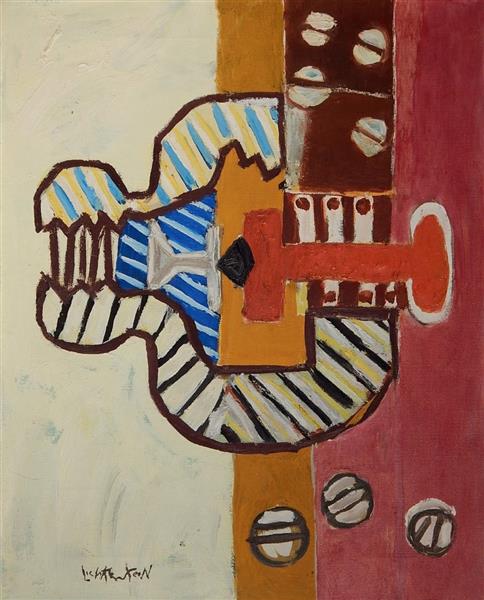
- In 1951, Lichtenstein held his first solo exhibition at the Carlebach Gallery in New York. He moved to Cleveland the same year and lived there for six years, although he often returned to New York.
- In 1957, Lichtenstein moved back to upstate New York. Then, he began teaching in upstate New York at the State University of New York at Oswego in 1958.
- In 1960, Lichtenstein started teaching at Rutgers University and was heavily influenced by Allan Kaprow who a pioneer in establishing the concepts of performance art.
- In 1961, Lichtenstein first time created the works with large-scale use of hard-edged figures and Ben-Day dots. This unprecedented attempt of combining comic and abstraction brought him unexpected commercial achievement later.

- From February 10 to March 3, 1962, Lichtenstein’s first exhibition of the comic-book paintings was held at Leo Castelli Gallery. The show sold out all of the exhibited works and made Lichtenstein famous.
- In 1963, Lichtenstein moved from New Jersey to Manhattan and resigned from Douglass in 1964 to concentrate on his work.
- In 1970, Lichtenstein purchased a former carriage house in Southampton, Long Island, built a studio on the property, and spent the rest of the 1970s in relative seclusion.
- Since August 1997, Lichtenstein suffered from pneumonia and numerous complications from this ailment. On September 29, 1997, Lichtenstein passed away.
Style
.jpg)
Not like some of the tortuous artists who constantly break their cognitions and rebuilt their style such as Winslow homer, Lichtenstein’s arts are more like a vertical development that digging into a deeper understanding of itself.
From the very beginning, his work was strongly connected with solid lines and shapes. This is the basis even the innermost nature of his all works. Those could be considered as the impact of abstractionism and cubism. As well as other artists who experienced the war, Lichtenstein created some of the war-related works but they are not depressive topics and more like the encouraging posters. Maybe because the US was easy on the front line.
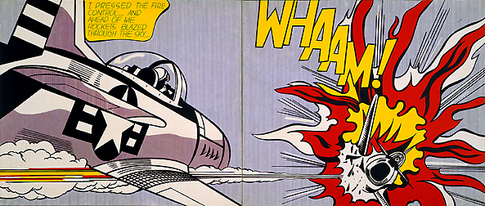
Although not obvious to see the change, Lichtenstein’s art was very well combined with the raising of Abstract Expressionism in that period. He made his work more emotional by the shapes itself, instead of expressing the practical story. Comics were really had a close connection to his development. The comic creation made him famous and further pushed his creation in the early 1960s. Conversely, he also changed the forms and creation of comics. His largely using of Ben-Day dots totally changed the way of the comic, and this influence can still be still seen until today.
.jpg)
After the period of commercial comic advertisements, the thoughts of Cubism, abstractionism and expressionism had a further fusion in Lichtenstein’s arts. This mixed-style became the main theme of his 1970s arts. Until the later 1980s, the characteristic expressionism shortly became the main thoughts in his works.
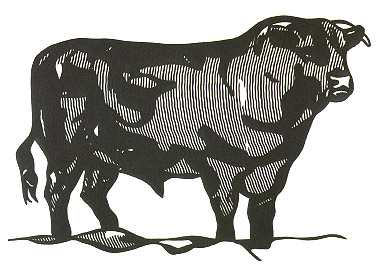
Roy Lichtenstein, Bull I, 1973 
Roy Lichtenstein, Bull III, 1973 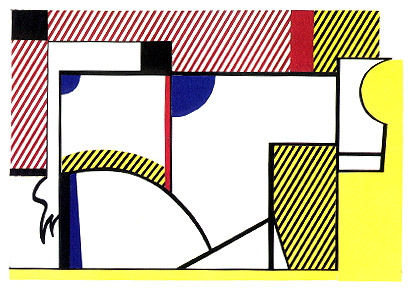
Roy Lichtenstein, Bull VI, 1973
.jpg)
However, through the recreation of old arts in the 1990s, Lichtenstein gets back to his own mixed style. The regular lines and shapes and solid filling colours appeared as the protagonists again in Lichtenstein’s creation. I personally believe this was caused by the spread of the computer.
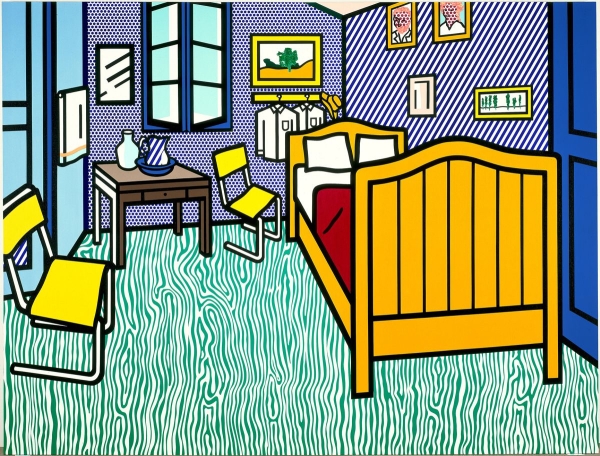
Personal Opinions
Roy Lichtenstein found his style and road very early and became successful when he was 30. This can be considered as a really lucky artist who still had a lot of time and resource to further develop his arts. Indeed he tried. The cubism, abstractionism and expressionism displayed in his 1970s-1980s works were really great attempt and he was so close to breaking his own limit and pattern. However, until the end, Lichtenstein did not really achieve a new hight. He was restricted by his own cognitions in his young period and did not get rid of the success in the past. His later work cannot give people an astonishing sense of the same as his peak in the 1960s. He was just copying his works in the past.
References
https://lichtensteinfoundation.org/biography/ https://www.roylichtenstein.com/ https://www.wikiart.org/en/roy-lichtenstein/the-valve-1954 https://www.wikiart.org/en/roy-lichtenstein/drowning-girl-1963 https://www.wikiart.org/en/roy-lichtenstein/face-green-nose-1986 https://www.wikiart.org/en/roy-lichtenstein/bedroom-at-arles-1992 https://www.wikiart.org/en/roy-lichtenstein/bull-i-1973 https://www.wikiart.org/en/roy-lichtenstein/bull-iii-1973 https://www.wikiart.org/en/roy-lichtenstein/bull-vi-1973 https://en.wikipedia.org/wiki/Look_Mickey https://en.wikipedia.org/wiki/Roy_Lichtenstein https://en.wikipedia.org/wiki/Whaam!